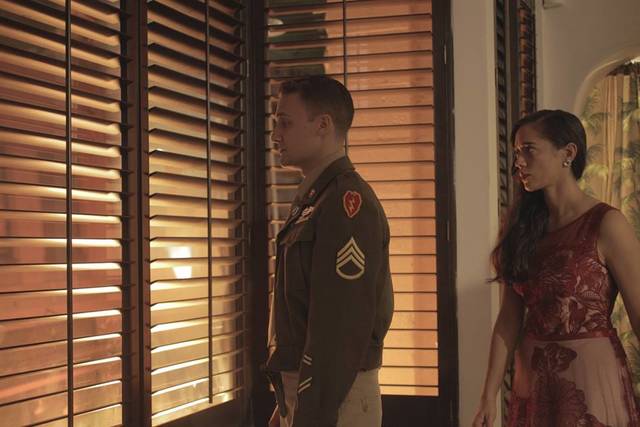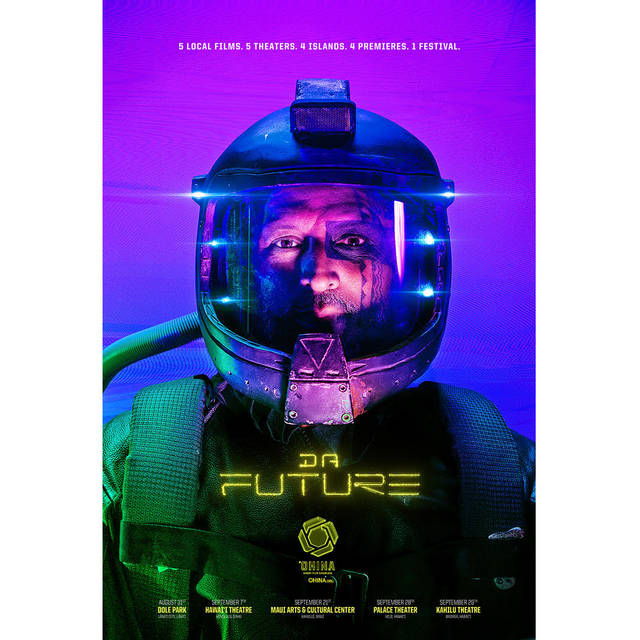KAILUA-KONA — Stories of prejudice, the effects of war and human connection — the film “Last Taxi Dance” has them all.
Three heavy subjects are packed into the 18-minute short film that takes place near the end of World War II, a period that writer and director Brayden Yoder believes has similarities to modern times.
Set in Honolulu’s Chinatown in 1945, “Last Taxi Dance” tells the story of a taxi dancer, Mahea, and the lonely, unnamed U.S. soldier she finds herself with. As their conversation unfolds throughout the night, the two characters learn to overcome their respective prejudices against each other and see the world from another point of view.
Oahu-native Yoder’s vision for “Last Taxi Dance” came together as he witnessed an intense time in American politics, and that theme runs parallel to the film’s 1940s Hawaii setting.
“I actually wrote it in Dec. 2015, just as the presidential election was heating up. All the elements of politics, divisiveness and the vitriol from that time period, it made me want to do a story that was more about connecting than division,” Yoder said. “The theme of the film is about connection. How to bridge differences across cultures.”
“Last Taxi Dance” will make its premiere on Hawaii Island at the Palace Theater in Hilo on Friday as one of five films showing as part of the Ohina Short Film Showcase. The showcase, along with “Last Taxi Dance,” will also be playing at 7 p.m. Saturday at the Kahilu Theatre in Waimea. This is the first year that the Ohina Short Film Showcase will be at the Kahilu Theatre.
“Last Taxi Dance” was filmed over the course of four days in February in Honolulu’s Chinatown, and made its world premiere last month at the Hawaii Theatre on Oahu. The film stars two actors who frequent the Honolulu theatre stage together — Max Holtz, who plays the role of the solder, and Danielle Zalopany. All the actors in the film are Honolulu locals.
Casting for the film came easy for Yoder and the rest of the crew. Zalopany was cast as the lead female role Mahea without having to audition.
“She was the only choice,” Yoder said. “She had just been cast in a film called ‘Waikiki’ and my producer saw her audition tape and said ‘Wow, this woman would be amazing for Mahea.’ And it really wasn’t a hard decision. I just kind of knew she was the right one.”
For the soldier, Zalopany recommended Holtz, who has been a part of the Honolulu theatre scene for the last three years. Having worked with each other prior to “Last Taxi Dance” made the process of filming more comfortable for both actors.
“I’ve done a ton of plays and a lot of stage work, but never film,” Holtz said. “There was a lot that was really new with being on the set and film acting, and having Dani, who is someone who I know really well and someone who I’m comfortable acting with, made a huge difference.”
While Holtz found the transition to film from theater a challenging experience, he said his character and the theme of the film resonated with his personal experiences of moving from Washington, D.C., to Hawaii several years ago.
“As someone who didn’t grow up in Hawaii, I definitely connect a lot with my character’s experience in this film,” Holtz said. “A lot of it is him learning about the Hawaiian experience as an outsider.”
Zalopany had her own family history from World War II to look back on and find inspiration for the character of Mahea the taxi dancer. Taxi dancers were women hired, usually for a price around 10 cents, to dance one-on-one with a customer. Taxi dance clubs were popular in the 1920s and 1930s, especially in larger American cities such as New York, Chicago and Honolulu. By the end of World War II, taxi dance clubs were on their way out.
“My family, we’ve lived on the islands forever and that’s actually a time when my grandmother was alive, so she would talk about it,” Zalopany said. “One of my grandfathers actually owned a restaurant in Chinatown during World War II that would cater to the soldiers. He owned a taxi cab and would go down to Pearl Harbor and pick up the soldiers on leave and take them to his restaurant.”
Yoder, a veteran of the Iraq War who previously directed the 2013 short film “Breakdown,” also brought his past experience into making “Last Taxi Dance.” He said being an officer in the military was what helped him learn the discipline and management skills needed to be a filmmaker, and the angst of the soldier’s character is what resonated with him the most.
“Creatively, being in Iraq and the clash of cultures, my work derived from that,” Yoder said, “And the question is, are we fated to fighting forever, or is there a way to get along. I think about Hawaii and how we, generally, get along here, and those themes kind of led to ‘Last Taxi Dance,’ which is my most hopeful version of that theme.”
Holtz said the film is about human connection and how to bridge the divide between two cultures. The cast and crew hope that theme will resonate with audiences throughout Hawaii.
“I really hope that people can take away that we need to be more understanding, accepting and not jump to conclusions,” Zalopany said. “To look at each other as human beings and realize that we all have our sort of emotional baggage to bear. And sometimes that connects us more than we would assume.”
Info: The Ohina Short Film Showcase is a free event to begin 7 p.m. Saturday at the Kahilu Theatre in Waimea.









Not one single Hawaiian or
local male in this racist production based in Hawaii. Tired racist white savior trope.